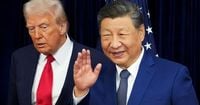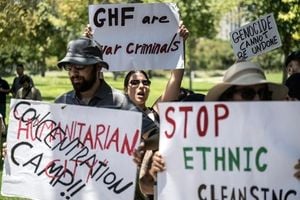As global tensions simmer in East Asia, Taiwan is edging closer to a landmark trade agreement with the United States that could reshape the world’s semiconductor landscape and reverberate through international relations. According to Reuters, the deal—still under negotiation—would see Taiwanese chipmakers like TSMC train American workers in advanced manufacturing, expand their U.S. operations, and help build out science park infrastructure, all in exchange for a reduction in the steep 20% tariffs currently levied on most Taiwanese exports to the U.S.
The arrangement, if finalized, is expected to mirror deals the U.S. has already struck with South Korea and Japan, both of which pledged massive investments in the American economy—$350 billion and $550 billion, respectively—to secure lower tariffs on their goods. Taiwan’s total investment would be smaller, but its significance could be even greater, given the island’s outsized role in the global semiconductor supply chain. The Financial Times recently reported that Taiwan’s cumulative investment could reach $400 billion, though sources caution that figures remain fluid as talks continue.
Semiconductors, the lifeblood of everything from smartphones to artificial intelligence, have so far been exempt from tariffs while the U.S. scrambles to build up its own chipmaking capacity. Still, the stakes are high. TSMC, the world’s largest contract chipmaker, is already investing $165 billion to construct new factories in Arizona, but the company has struggled to find enough skilled workers. In January, TSMC CEO CC Wei bluntly stated that building in Arizona has taken at least twice as long as in Taiwan, citing shortages of skilled labor and supply chain hiccups. "It is very difficult for other countries to do this kind of work, because only we have this concept, practice, and track record of service parks, which allows us to undertake this kind of initiative in the United States," Taiwan Vice Premier Cheng Li-chiun explained last month, according to Reuters.
In an effort to address these challenges, Taiwan’s Office of Trade Negotiations said its team is working closely with U.S. counterparts to share the island’s expertise in supply chain management and science park development, a model that has powered Taiwan’s rise since the 1980s. The hope is to replicate the so-called “Taiwan model” in the U.S., helping American workers and industries climb the learning curve that has made Taiwan a global chip powerhouse. "We are at the stage of exchanging documents to firm up certain details," Taiwan Premier Cho Jung-tai told reporters in Taipei on November 26, 2025, signaling that negotiations are progressing but not yet finalized.
Vice Premier Cheng, who is leading the talks to reduce tariffs on Taiwanese exports, expressed optimism last month that a consensus on expanded U.S. investment could be reached soon. Still, as Reuters notes, the specifics of the deal remain in flux, with sources warning that any terms could shift before a final agreement is inked. White House spokesman Kush Desai added a note of caution: “Reporting about potential trade deals is speculation” until an official announcement is made by former President Trump.
While the economic logic is compelling, geopolitics loom large over the negotiations. Taiwan’s most advanced semiconductor technologies and research will remain firmly rooted on the island, both for legal and strategic reasons. TSMC, for example, is bound by law to keep the bulk of its production in Taiwan, a policy that underscores the island’s strategic importance as the world’s chip supplier. Domestically, chipmakers like TSMC are seen as a “sacred mountain” that shields Taiwan from external threats, especially from China, which claims the democratically governed island as its own territory.
The timing of the trade talks is no coincidence. China has ramped up its rhetoric and military posturing around Taiwan in recent weeks. On November 24, 2025, Chinese President Xi Jinping spoke with Donald Trump by phone, emphasizing that Taiwan’s “return to China” remains a crucial issue for Beijing. The White House has not commented on that part of the conversation. Just two days later, Beijing issued a stark warning that it would “crush” any foreign interference in Taiwan, following Japan’s announcement of plans to deploy missiles to an island near Taipei. These developments have come amid a broader escalation in the region: China has slapped a no-travel advisory on Japan, banned some Japanese seafood imports, and stepped up military drills in the East China Sea, while Japan has expanded its own military preparedness.
Amid this tense backdrop, the U.S. has continued to assert its role as Taiwan’s most important international backer and security guarantor, despite the lack of formal diplomatic ties. On November 26, 2025, Raymond Greene, director of the American Institute in Taiwan (the de facto U.S. embassy), publicly welcomed Taiwan President Lai Ching-te’s introduction of a $40 billion defense budget in response to the rising threat from China. “The United States supports Taiwan’s rapid acquisition of critical asymmetric capabilities needed to strengthen deterrence,” Greene wrote in a Facebook post. “The entire world has a stake in ensuring that differences across the Taiwan Strait are resolved peacefully and free from coercion.”
At the same time, former President Trump has been working to keep the economic peace on multiple fronts. After a one-hour call with Xi Jinping on November 24, Trump told reporters that Xi had “more or less agreed” to accelerate and expand Chinese agricultural purchases from the U.S.—a move that could help American farmers hit hard by a year-long effective boycott. “I think he’s going to very much surprise you on the upside,” Trump said aboard Air Force One on November 25. “I asked him, ‘I’d like you to buy a little faster, I’d like you to buy a little more.’ And he’s more or less agreed to do that.” Trump also briefed Japanese Prime Minister Sanae Takaichi on the conversation, describing their discussion as “great.”
While the U.S. pushes for a settlement of key details from the Trump-Xi truce struck in October in South Korea, officials are also racing to finalize “general licenses” for Chinese exports of rare earths and critical minerals by the end of November. These minerals are vital for everything from smartphones to electric vehicles, and China’s earlier blockade of rare earth exports had sent shockwaves through global supply chains.
For Taiwan, the stakes couldn’t be higher. The island’s ability to maintain its technological edge and global relevance is seen as a bulwark against both economic and military pressures from Beijing. As negotiations with the U.S. continue, Taipei’s balancing act—deepening its economic ties with Washington while keeping its most advanced technologies at home—will be watched closely by allies and rivals alike. With every diplomatic move, Taiwan is not just bargaining for lower tariffs or bigger investments; it’s negotiating its place in a rapidly shifting world order, one silicon wafer at a time.




